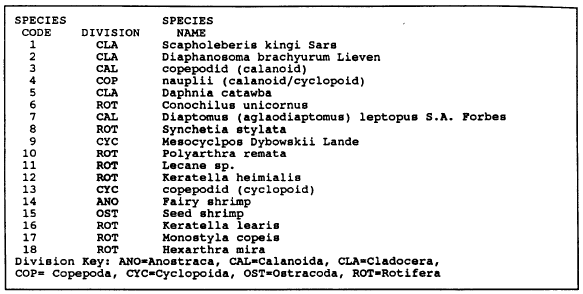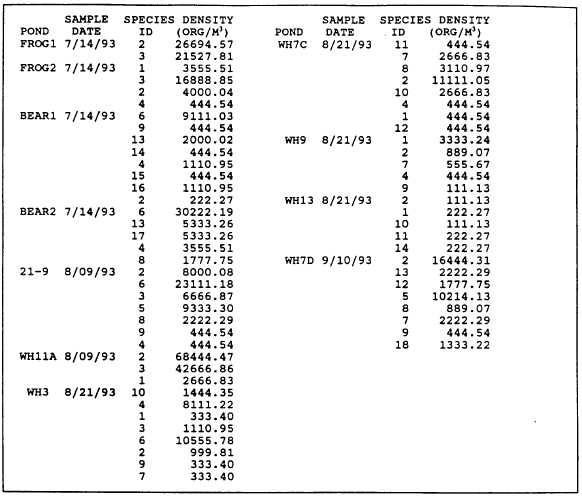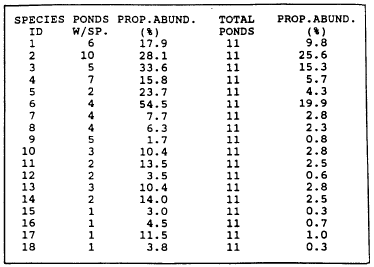3.2.2 Zooplankton
The zooplankton exhibited more diversity than did the phytoplankton, probably as a result of the greater number of samples and the larger period of time over which the zooplankton samples were obtained.
There were eleven zooplankton samples taken over a period from July 14 – Sept. 10, 1993 (Table 8). From those samples, 18 different organisms were identified; 8 rotifers, 3 cladorcerans, 2 calanoid copepods, 2 cyclopoid copepods, 1 nauplii (combined both calanoid and cyclopoid), 1 fairy shrimp, and 1 seed shrimp (Table 7). The number of species identified within each sample, ranged from a low of two in FROG 1 (7/14/93) to a high of 8 species in 4 ponds; BEARI (7/14/93, a surface tow), WH3 (8/21/93), WH7C (8/21/93), and WH7D (9/10/93) (Table 8). In comparing the proportional abundance, the dominate species was Diaphanosoma brachyurum Lieven (25.6%), a cladoceran, and the lowest was the seed shrimp and Hexarthra mira at 0.3% (Table 9). On a divisional basis, the cladocerans had the highest proportional abundance (39.8%) and the seed shrimp the lowest (0.3%).
The percent similarity, in which all species identified within a sample are used in comparing between all samples, showed that ponds FROG1 and WH11A had the greatest similarity at 92.4%, and the two BEAR samples at 80.2% (Table 10). Sample BEAR2 had no percent similarity (0.0%) with three other samples , FROG 1, WH11 A, and WH13. Nine other sample combinations had similarities over 50%. Of the total different possible similarity combinations (55), 31 were less than 25% similar.
Table 11 shows the compilation of zooplankton taxa into divisions. The sample BEARI, with eight taxa, had the greatest number of divisions, six. Two samples, FROG 1 and WH1 1A had only 2 divisions and 2 and 3 taxa, respectively.
|
TABLE 7. Zooplankton species list with their corresponding codes and taxonomic division. |
|
TABLE 8. Zooplankton sample ponds, dates sampled, species identified and cell densities (organisms/m 3). |
|
TABLE 9. Zooplankton species, number of ponds where identified and proportional abundance, total ponds sampled and corresponding proportional abundance based on if species was found in all ponds. |




